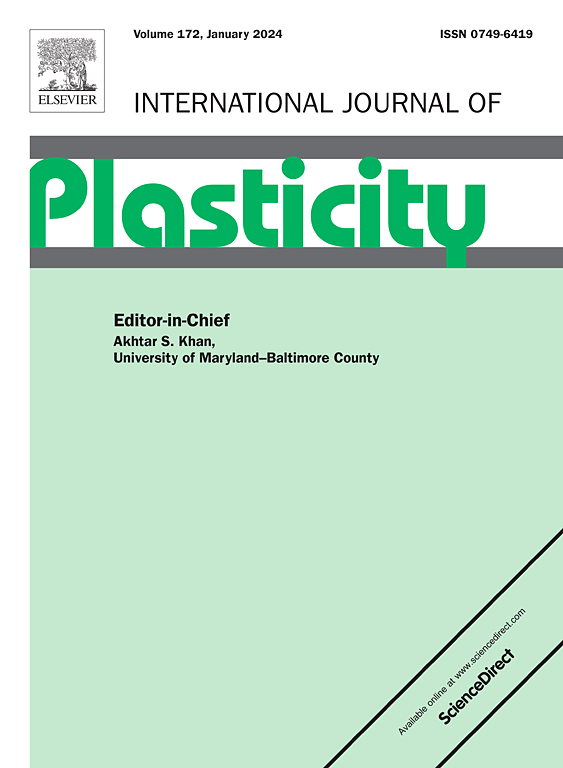Achieving synergistic strength-ductility in a novel refractory high-entropy alloy from room to high temperatures through nano-silicide precipitation-mediated dislocation dynamics
IF 12.8
1区 材料科学
Q1 ENGINEERING, MECHANICAL
引用次数: 0
Abstract
Refractory high-entropy alloys (RHEAs) face critical challenges in reconciling room-temperature ductility with high-temperature strength retention and microstructural stability for extreme-condition applications. Here, we develop a novel non-equimolar and low-density (V30Nb40Ti20Ta10)99Si1 RHEA (7.91 g/cm3) that achieves unprecedented synergy of ambient deformability and elevated-temperature performance via nano-silicide precipitation engineering and dislocation dynamics optimization. The alloy achieves an exceptional strength-ductility synergy at room temperature (yield strength: 958 MPa, fracture strain: 33.1 %, uniform tensile elongation: 15.7 %) via nano-silicide-mediated cross-slip, multi-planar slip, and hierarchical dislocation substructure evolution. At 1000 °C, the alloy retains 258 MPa yield strength with 76 % elongation, outperforming conventional wrought superalloys. Multiscale analysis reveals that the combined effects of precipitation strengthening and DRX-driven microstructure evolution allow (V30Nb40Ti20Ta10)99Si1 to preserve its mechanical integrity under severe thermomechanical environments. Long-term heat exposure (120 h at 1000 °C) proves the alloy's high stability, exhibiting negligible microstructural evolution and >99 % strength retention. The balance of mechanical properties and microstructural stability enables the novel RHEA to stand out among RHEAs. This study offers critical insights into designing RHEAs that achieve a balance of ambient deformability, high-temperature strength, and microstructural stability, thereby enhancing their potential for aerospace and turbine material applications.


通过纳米硅化物沉淀介导的位错动力学实现新型难熔高熵合金从室温到高温的协同强度-延展性
耐火高熵合金(RHEAs)在协调室温延展性与高温强度保持和极端条件下的显微组织稳定性方面面临着严峻的挑战。在这里,我们开发了一种新型的非等摩尔低密度(V30Nb40Ti20Ta10)99Si1 RHEA (7.91 g/cm3),通过纳米硅化物沉淀工程和位错动力学优化,实现了前所未有的环境变形性和高温性能的协同作用。在室温下,该合金通过纳米硅化物介导的交叉滑移、多平面滑移和分层位错亚结构演化获得了优异的强度-塑性协同效应(屈服强度:958 MPa,断裂应变:33.1%,均匀拉伸伸长率:15.7%)。在1000℃时,合金的屈服强度为258 MPa,伸长率为76%,优于传统的变形高温合金。多尺度分析表明,沉淀强化和drx驱动的微观组织演变的共同作用使得(V30Nb40Ti20Ta10)99Si1在恶劣的热机械环境下仍能保持其力学完整性。长期热暴露(在1000°C下120小时)证明了合金的高稳定性,表现出可以忽略不计的微观组织演变和99%的强度保持。机械性能和微观结构稳定性的平衡使新型RHEA在RHEAs中脱颖而出。该研究为设计实现环境可变形性、高温强度和微观结构稳定性平衡的rhea提供了关键见解,从而增强了其在航空航天和涡轮材料应用中的潜力。
本文章由计算机程序翻译,如有差异,请以英文原文为准。
求助全文
约1分钟内获得全文
求助全文
来源期刊

International Journal of Plasticity
工程技术-材料科学:综合
CiteScore
15.30
自引率
26.50%
发文量
256
审稿时长
46 days
期刊介绍:
International Journal of Plasticity aims to present original research encompassing all facets of plastic deformation, damage, and fracture behavior in both isotropic and anisotropic solids. This includes exploring the thermodynamics of plasticity and fracture, continuum theory, and macroscopic as well as microscopic phenomena.
Topics of interest span the plastic behavior of single crystals and polycrystalline metals, ceramics, rocks, soils, composites, nanocrystalline and microelectronics materials, shape memory alloys, ferroelectric ceramics, thin films, and polymers. Additionally, the journal covers plasticity aspects of failure and fracture mechanics. Contributions involving significant experimental, numerical, or theoretical advancements that enhance the understanding of the plastic behavior of solids are particularly valued. Papers addressing the modeling of finite nonlinear elastic deformation, bearing similarities to the modeling of plastic deformation, are also welcomed.
 求助内容:
求助内容: 应助结果提醒方式:
应助结果提醒方式:


